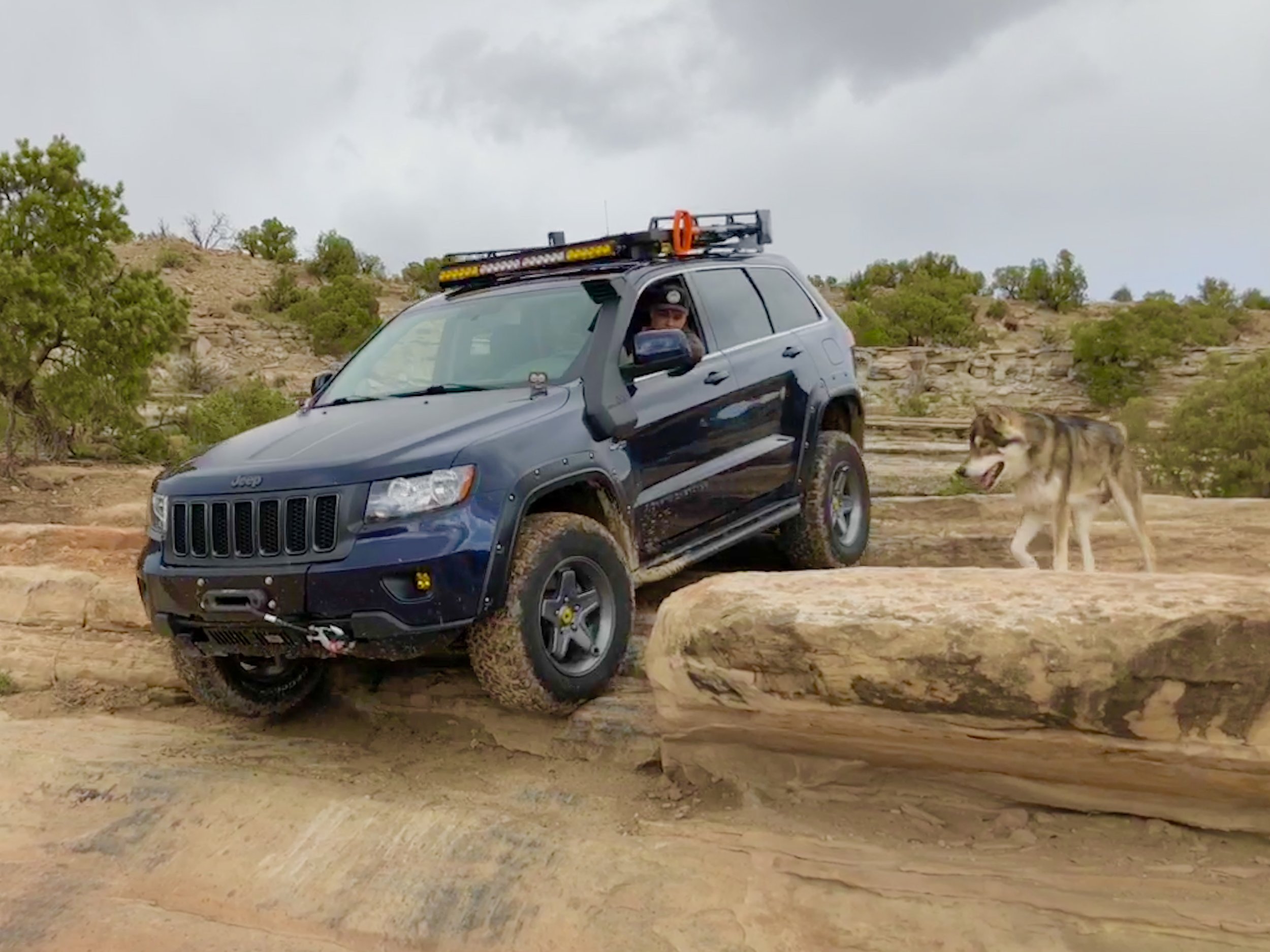Suspension and Rolling Stock
Tackling some ledges at Bang’s Canyon ORV area
An ongoing experiment…
It was previously mentioned that a WK2 without the Quadra-Lift suspension was purposely chosen so permanent modifications could be made to the suspension for off road optimization. If you purchased a WK2 with the Quadra-Lift, you cannot effectively modify the suspension for a lift. Sensor links and even add-on controllers are available to trick the drivetrain controllers into lifting the suspension whenever the Jeep is in operation. These modifications are not without risk to the electromechanical systems, and frankly, negate the versatility of a Jeep equipped with Quadra-Lift. It is worth noting that there are modified WK2s out there in the world running up to 35” tires on a Quadra-Lift. The most notable are from Arctic Trucks out of Iceland. This is achieved through extensive custom bodywork combined with high quality custom built fender flares. It could be duplicated if you had the time and resources. The primary reason a standard suspension for modification was chosen is due to the permanent installations that add weight to the vehicle (such as the winch, rack, and future tire carrier), and because the Jeep will be used mostly for off-pavement adventures.
The current suspension configuration has undergone multiple changes, but may be finally finished. The front suspension is fitted with ARB Old Man Emu 3085 heavy rate springs, Bilstein 5100 struts set at the middle position, and Rocky Road upper A-arms. The rear is fitted with ARB Old Man Emu 3060 heavy rate springs and the self-leveling Nivomat towing struts. After trying several configurations, this is likely the final setup as the lift height and spring rate seems to be where I want it. It is possible to get close to 4” of total lift if you Frankenstein your setup on a WK2. It admittedly looks cool, but I ran this kind of setup for a time, and it has the suspension struts nearly topped out in a static running height. It was hard on the half shafts and when on the trail, the suspension would top out and clunk on almost every bump. The ride was also expectedly compromised. Of note is that some aftermarket “extended heavy duty” sway bar links were originally installed, but they did not have ball ends, so the mounting bolts broke on these when crossing Imogene Pass, eventually causing front half shaft damage. Those links also required frequent greasing and maintenance. Any lift that can reasonably be installed on a WK2 will still be within the original suspension operating parameters, so extended links are simply not necessary for a lift to function. Heavy use in rough terrain can certainly wear or break the factory link hardware at an accelerated pace, but they are not very expensive to replace, and do not require upgrade in my opinion.
An old adage is that “the only true lift in a 4x4 comes with tires”. Larger diameter tires are the only way that true ground clearance beneath the axles is achieved. Suspension lifts primarily provide clearance for larger tires, but can also assist in creating chassis clearance from trail obstacles, increasing the critical approach, departure, and breakover angles. Ultimate tire size on a WK2 is an issue. It is reasonable to only expect a 33” diameter tire fully functional on a WK2 regardless of suspension lift configuration. In stock form, a 265 mm wide tire in various wheel configurations is the largest fitted. This should be considered the optimum size for all WK2s. With certain wheel offsets and backspacing, a 275 mm tire can be ran with minimal rubbing of inner fenders. A 285 mm tire (such as a 285/70 R17 which is a true 33 inch tire) is possible with proper wheels, a lift, and some trimming in the front fenders.
The Trail Wolf is currently running the 285 tire. For this to work with the wheel and tire combo, it required the “pinch weld mod” and some trimming of the bumper plastic and modification of the Bushwacker flares. This involved cutting a thin pie shape from the flare and putting back together with a plastic welder. New hardware and rivet nuts were also used in the modification to reattach the fender flares.
It’s worth mentioning that to run tires this size on previous generation Grand Cherokee models required 4-6 inches of suspension lift and some fender cutting as well. A point of fact is that MOPAR featured an orange diesel WK2 at Moab in 2013 called the “Trailhawk 2” which featured 35” equivalent tires purportedly fitted with significant fender cutting and custom flares. A tire this size would obviously create some fuel consumption and drivability issues for regular use unless it became possible to regear the differentials. This is still not an option in 2022.
The Flatwater WK2 has been fitted with AEV (American Expedition Vehicles) Pintler wheels in the Argent colorway. (the metallic grey “Argent” color is no longer available) These wheels are meant for the JK Jeep Wrangler, but fit well on the WK2 with splined lug nuts. They have +10mm positive offset and added width at 8.5” overall, but still sit nearly perfectly under the Jeep. Wrangler JL wheels have a shallower offset and may be a better fit, but this is not independently confirmed on my part. Tires have been upgraded to 285/70 R17 BF Goodrich A/T KO2. These have been great all-around tires, but do have limitations. Fender and fender flare trimming as well as the “pinch weld mod” were requried to eliminate rubbing at full lock and suspension travel as described above.


